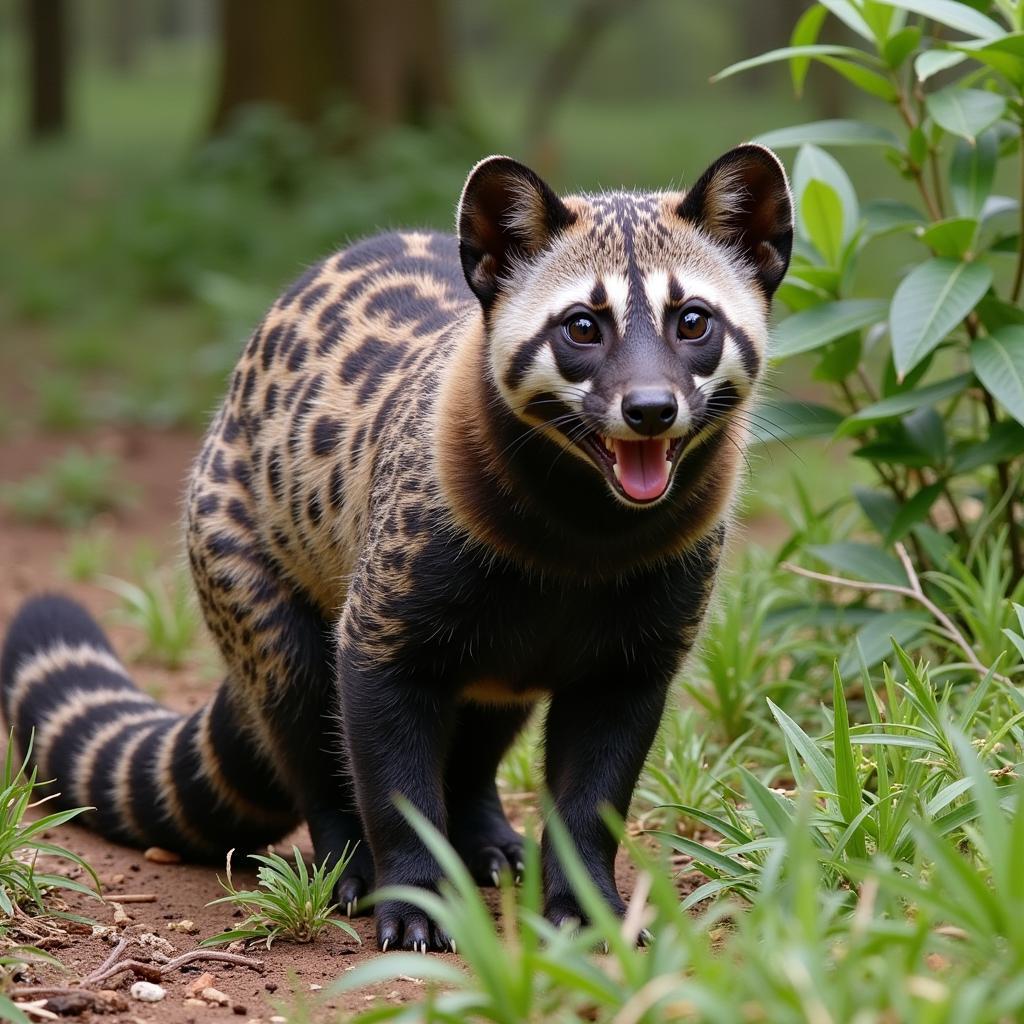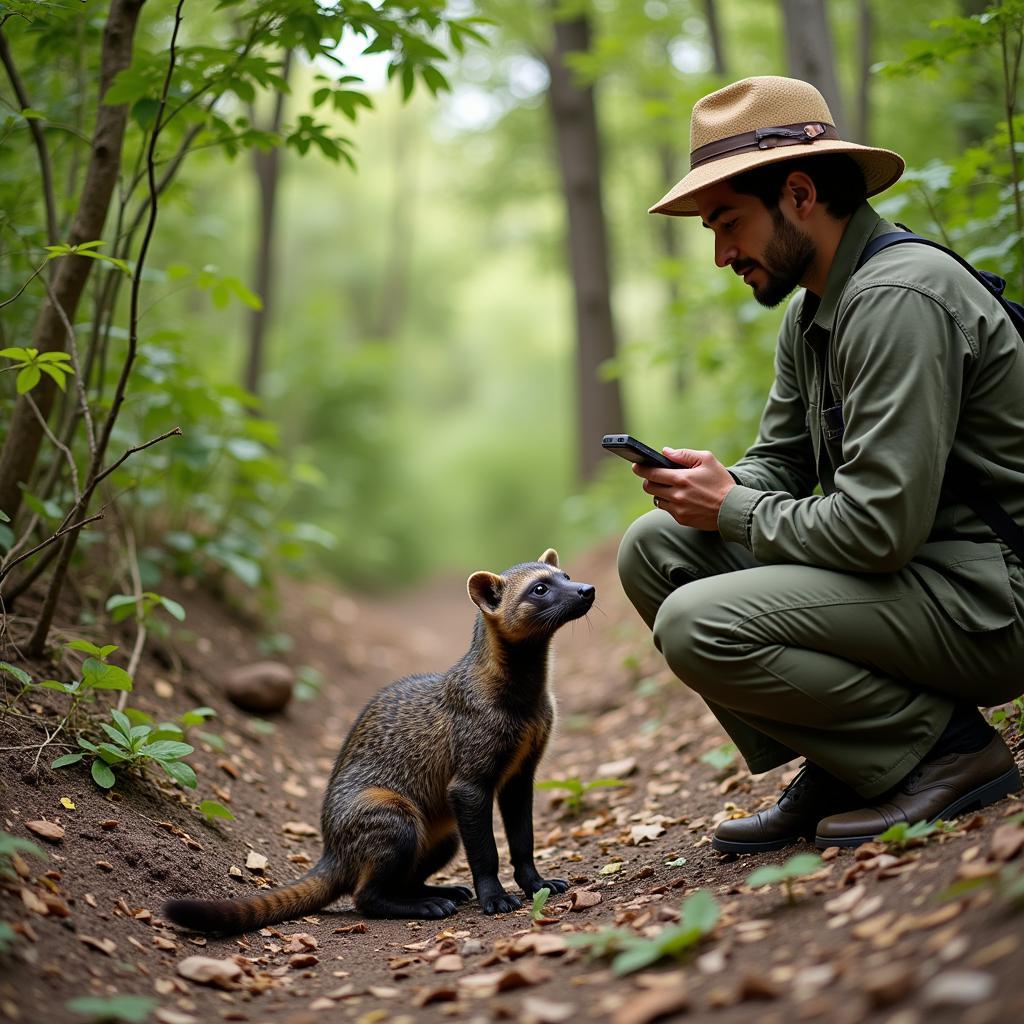African Civet in Afrikaans: Unveiling the “Muskeljaatkat”
The African civet, known as the “muskeljaatkat” in Afrikaans, is a fascinating creature shrouded in a blend of mystique and misunderstanding. This article delves into the captivating world of these nocturnal mammals, exploring their unique characteristics, habitat, diet, cultural significance, and the importance of conservation efforts.
Understanding the Muskeljaatkat: A Closer Look at the African Civet
African civets, belonging to the family Viverridae, are small, cat-like carnivores indigenous to sub-Saharan Africa. Their Afrikaans name, “muskeljaatkat,” translates to “civet cat,” highlighting their resemblance to felines. However, they are more closely related to mongooses and genets. These creatures are characterized by their elongated bodies, short legs, pointed snouts, and a distinctive black and white facial marking resembling a bandit’s mask. Their coarse fur, often a grizzled grey or yellowish-brown, is marked with dark spots and stripes, providing excellent camouflage in their diverse habitats.
One of the most remarkable features of the African civet is its perineal gland, which secretes a musky substance called civetone. Historically, this secretion was highly prized in the perfume industry, leading to the capture and farming of civets for this purpose.
 African Civet (Muskeljaatkat) in its Natural Habitat
African Civet (Muskeljaatkat) in its Natural Habitat
Habitat and Diet: Where the Muskeljaatkat Roams and What it Eats
African civets exhibit remarkable adaptability, thriving in a wide range of habitats, from savannas and woodlands to forests and even mountainous regions. They are primarily terrestrial, but are also agile climbers, often utilizing trees for refuge and hunting. These nocturnal creatures are rarely seen during the day, preferring to remain hidden in dense vegetation or burrows.
The “muskeljaatkat” is an omnivorous opportunist, with a diet as diverse as its habitat. They primarily feed on small mammals, birds, reptiles, insects, and fruits. Their strong jaws and sharp teeth enable them to tackle prey larger than themselves. They also play a vital role in seed dispersal, contributing to the health and regeneration of their ecosystems.
Cultural Significance and Conservation: Protecting the Muskeljaatkat
In some African cultures, the African civet holds symbolic meaning, often associated with cunning and resourcefulness. However, their historical exploitation for civetone has had a significant impact on their populations. While synthetic alternatives to civetone are now widely available, habitat loss and human-wildlife conflict continue to pose threats to their survival.
The Future of the African Civet (Muskeljaatkat)
“Conservation efforts are crucial to ensure the long-term survival of the African civet,” states Dr. Lindiwe Mazibuko, a renowned wildlife biologist specializing in African mammal conservation. “Protecting their natural habitats and raising awareness about their ecological importance are key to their future.”
 African Civet Conservation Efforts
African Civet Conservation Efforts
African Civet FAQs
- What does “muskeljaatkat” mean? It is the Afrikaans word for African civet, translating to “civet cat.”
- Are African civets dangerous? They are generally not considered dangerous to humans, but can bite if threatened.
- What do African civets eat? They are omnivores, eating a variety of foods, including small mammals, insects, fruits, and reptiles.
- Where do African civets live? They are found in various habitats across sub-Saharan Africa.
- Why are African civets important? They play a vital role in seed dispersal and contribute to the health of their ecosystems.
- What is civetone? It is a musky substance secreted by the African civet’s perineal gland, traditionally used in perfumery.
- Are African civets endangered? While not currently classified as endangered, they face ongoing threats from habitat loss and human-wildlife conflict.
Conclusion: Appreciating the Muskeljaatkat
The African civet, or “muskeljaatkat,” is a captivating creature that plays an essential role in the African ecosystem. By understanding their unique characteristics and supporting conservation efforts, we can help ensure the future of this remarkable animal.
More questions you might have about African wildlife:
- What are the different types of civets found in Africa?
- What are the conservation challenges faced by African wildlife?
- How can I contribute to African wildlife conservation?
For any further assistance or information, please do not hesitate to contact us. Call us at +255768904061, email us at kaka.mag@gmail.com, or visit us at Mbarali DC Mawindi, Kangaga, Tanzania. Our customer service team is available 24/7.